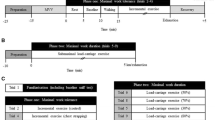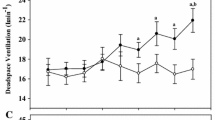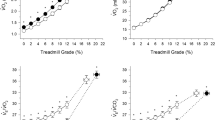Abstract
Purpose
The purposes of this experiment were to, first, document the effect of 45-kg thoracic loading on peak exercise responses and, second, the effects of systematic increases in thoracic load on physiological responses to submaximal treadmill walking at a standardized speed and grade.
Methods
On separate days, 19 males (age 27 ± 5 years, height 180.0 ± 7.4 cm, mass 86.9 ± 15.1 kg) completed randomly ordered graded exercise tests to exhaustion in loaded (45 kg) and unloaded conditions. On a third day, each subject completed four randomly ordered, 10-min bouts of treadmill walking at 1.34 m s−1 and 4 % grade in the following conditions: unloaded, and with backpacks weighted to 15, 30, and 45 kg.
Results
With 45-kg thoracic loading, absolute oxygen consumption (\( \dot{V}{\text{O}}_{2} \)), minute ventilation, power output, and test duration were significantly decreased at peak exercise. End-inspiratory lung volume and tidal volume were significantly reduced with no changes in end-expiratory lung volume, breathing frequency, and the respiratory exchange ratio. Peak end-tidal carbon dioxide and the ratio of alveolar ventilation to carbon dioxide production were similar between conditions. The reductions in peak physiological responses were greater than expected based on previous research with lighter loads. During submaximal treadmill exercise, \( \dot{V}{\text{O}}_{2} \) increased (P < 0.05) by 11.0 (unloaded to 15 kg), 14.5 (15–30 kg), and 18.0 % (30–45 kg) showing that the increase in exercise \( \dot{V}{\text{O}}_{2} \) was not proportional to load mass.
Conclusion
These results provide further insight into the specificity of physiological responses to different types of load carriage.





Similar content being viewed by others
Abbreviations
- f B :
-
Breathing frequency
- EELV:
-
End-expiratory lung volume
- EILV:
-
End-inspiratory lung volume
- FEV1 :
-
Forced expired volume in 1 second
- FPE:
-
Fire protective ensemble
- FVC:
-
Forced vital capacity
- IC:
-
Inspiratory capacity
- PaCO2 :
-
Partial pressure of arterial carbon dioxide
- PETCO2 :
-
Partial pressure of end-tidal carbon dioxide
- RER:
-
Respiratory exchange ratio
- \( \dot{V}_{\text{A}} \) :
-
Alveolar ventilation
- \( \dot{V}{\text{CO}}_{2} \) :
-
Carbon dioxide production
- \( \dot{V}{\text{O}}_{2} \) :
-
Oxygen consumption
- VT :
-
Tidal volume
References
Borg GA (1982) Psychophysical bases of perceived exertion. Med Sci Sports Exerc 14:377–381
Borghi-Silva A, Oliveira CC, Carrascosa C et al (2008) Respiratory muscle unloading improves leg muscle oxygenation during exercise in patients with COPD. Thorax 63:910
Dorman LE, Havenith G (2009) The effects of protective clothing on energy consumption during different activities. Eur J Appl Physiol 105(3):463–470
Epstein Y, Yanovich R, Moran DS, Heled Y (2013) Physiological employment standards IV: integration of women in combat units physiological and medical considerations. Eur J Appl Physiol 113:2673–2690
Faghy MA, Brown PI (2014) Preloaded time trial to assess load carriage performance. J Strength Cond Res 28:3354–3362
Givoni B, Goldman RF (1971) Predicting metabolic energy cost. Med Sci Sports Exerc 30:429–433
Guenette JA, With JD, McKenzie DC, Road JD, Sheel AW (2007) Respiratory mechanics during exercise in endurance-trained men and women. J Physiol 581(3):1309–1322
Harms C, Wetter T, St Croix C et al (2000) Effects of respiratory muscle work on exercise performance. J Appl Physiol 89:131–138
Johnson BD, Weisman IM, Zeballos RJ, Beck KC (1999) Emerging concepts in the evaluation of ventilatory limitation during exercise: the exercise tidal flow-volume loop. Chest 116:488–503
Knapik JJ, Reynolds KL, Harman E (2004) Soldier load carriage: historical, physiological, biomechanical, and medical aspects. Mil Med 169:45–56
Legrand R, Marles A, Prieur F et al (2007) Related trends in locomotor and respiratory muscle oxygenation during exercise. Med Sci Sports Exerc 39:91
Louhevaara V, Ilmarinen R, Griefahn B, Künemund C, Mäkinen H (1995) Maximal physical work performance with European standard based fire-protective clothing system and equipment in relation to individual characteristics. Eur J Appl Physiol 71(2–3):223–229
McLellan TM, Daanen HAM, Cheung SS (2013) Encapsulated environment. Compr Physiol 3:1363–1391
Miller MR, Hankinson J, Brusasco V et al (2005) Standardisation of spirometry. Eur Respir J 26:319–338
Nunneley SA (1989) Heat stress in protective clothing. Interactions among physical and physiological factors. Scand J Work Environ Health 15(Suppl 1):52–57
O’Donnell DE, Hong HH, Webb KA (2000) Respiratory sensation during chest wall restriction and dead space loading in exercising men. J Appl Physiol 88:1859–1869
Patton JF, Kaszuba J, Mello RP, Reynolds KL (1991) Physiological responses to prolonged treadmill walking with external loads. Eur J Appl Physiol 63:89–93
Petersen SR, Anderson GS, Tipton MJ, Docherty D, Graham TE, Sharkey BJ, Taylor NA (2016) Towards best practice in physical and physiological employment standards. Appl Physiol Nutr Metab 41(6 Suppl 2):S47–S62. doi:10.1139/apnm-2016-0003
Phillips DB, Stickland MK, Petersen SR (2016a) Ventilatory responses to prolonged exercise with heavy load carriage. Eur J Appl Physiol 116:19–27
Phillips Stickland MK, Lesser IA, Petersen SR (2016b) The effects of heavy load carriage on physiological responses to graded exercise. Eur J Appl Physiol 116:275–280
Phillips DB, Stickland MK, Petersen SR (2016c) Physiological and performances consequences of heavy thoracic load carriage in females. Appl Physiol Nutr Metab. doi:10.1139/apnm-2016-0002
Roberts D, Gebhardt DL, Gaskill S, Borges AS, Sharp MA (2016) Current considerations related to physiological differences between the sexes and physical employment standards. Appl Physiol Nutr Metab. 41(6 Suppl. 2):S108–S120. doi:10.1139/apnm-2015-0540
Ruby B, Leadbetter G, Armstrong D, Gaskill S (2003) Wildland firefighter load carriage: effects on transit time and physiological responses during simulated escape to safety zone. Int J Wildland Fire 12:111–116
Sheel AW, Romer LM (2012) Ventilation and respiratory mechanics. Compr Physiol 2:1093–1142. doi:10.1002/cphy.c100046
Sheel A, Derchak P, Morgan B et al (2001) Fatiguing inspiratory muscle work causes reflex reduction in resting leg blood flow in humans. J Physiol 537:277–289
Stickland MK, Lindinger MI, Olfert IM, Heigenhauser GJF, Hopkins SR (2013) Pulmonary gas exchange and acid-base balance during exercise. Compr Physiol 3:693–739
Taylor NAS, Lewis MC, Notley SR, Peoples GE (2012) A fractionation of the physiological burden of the personal protective equipment worn by firefighters. Eur J Appl Physiol 112:2913–2921
Taylor NAS, Peoples GE, Petersen SR (2016) Load carriage, human performance and physiological employment standards. Appl Physiol Nutr Metab. doi:10.1139/apnm-2015-0486
Teitlebaum A, Goldman RF (1979) Increased energy cost with multiple clothing layers. J Appl Physiol 32:743–744
Wang LY, Cerny FJ (2004) Ventilatory response to exercise in simulated obesity by chest loading. Med Sci Sports Exerc 36(5):780–786
West JB (ed) (2008) Respiratory physiology: the essentials, 8th edn. Williams & Wilkins, Baltimore
Acknowledgments
Technical assistance from Bradley Welch is appreciated. Cameron Ehnes was supported by the Undergraduate Research Initiative program at the University of Alberta.
Author information
Authors and Affiliations
Corresponding author
Ethics declarations
Conflict of interest
There are no conflicts of interest.
Additional information
Communicated by Susan Hopkins.
Rights and permissions
About this article
Cite this article
Phillips, D.B., Ehnes, C.M., Stickland, M.K. et al. The impact of thoracic load carriage up to 45 kg on the cardiopulmonary response to exercise. Eur J Appl Physiol 116, 1725–1734 (2016). https://doi.org/10.1007/s00421-016-3427-6
Received:
Accepted:
Published:
Issue Date:
DOI: https://doi.org/10.1007/s00421-016-3427-6




